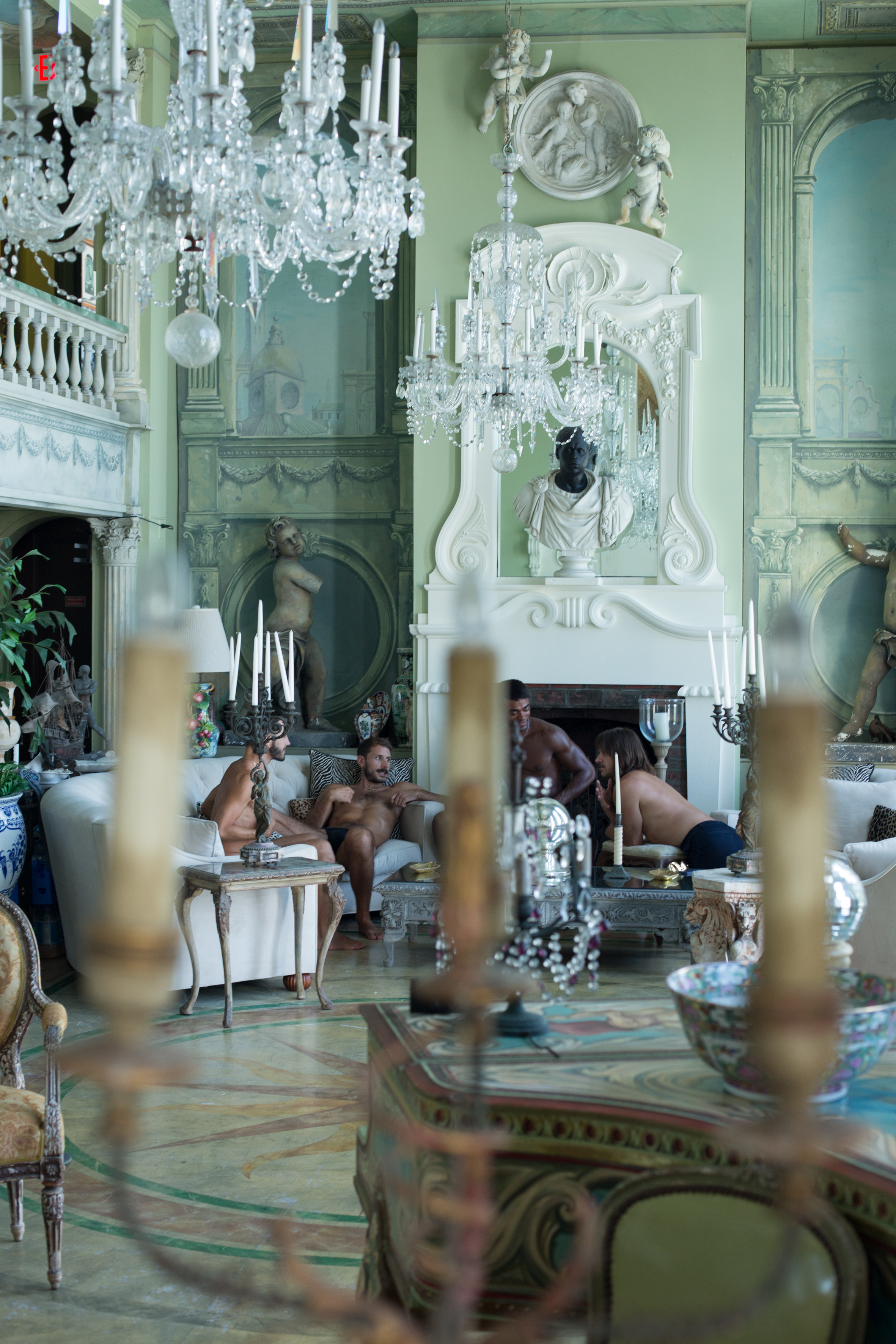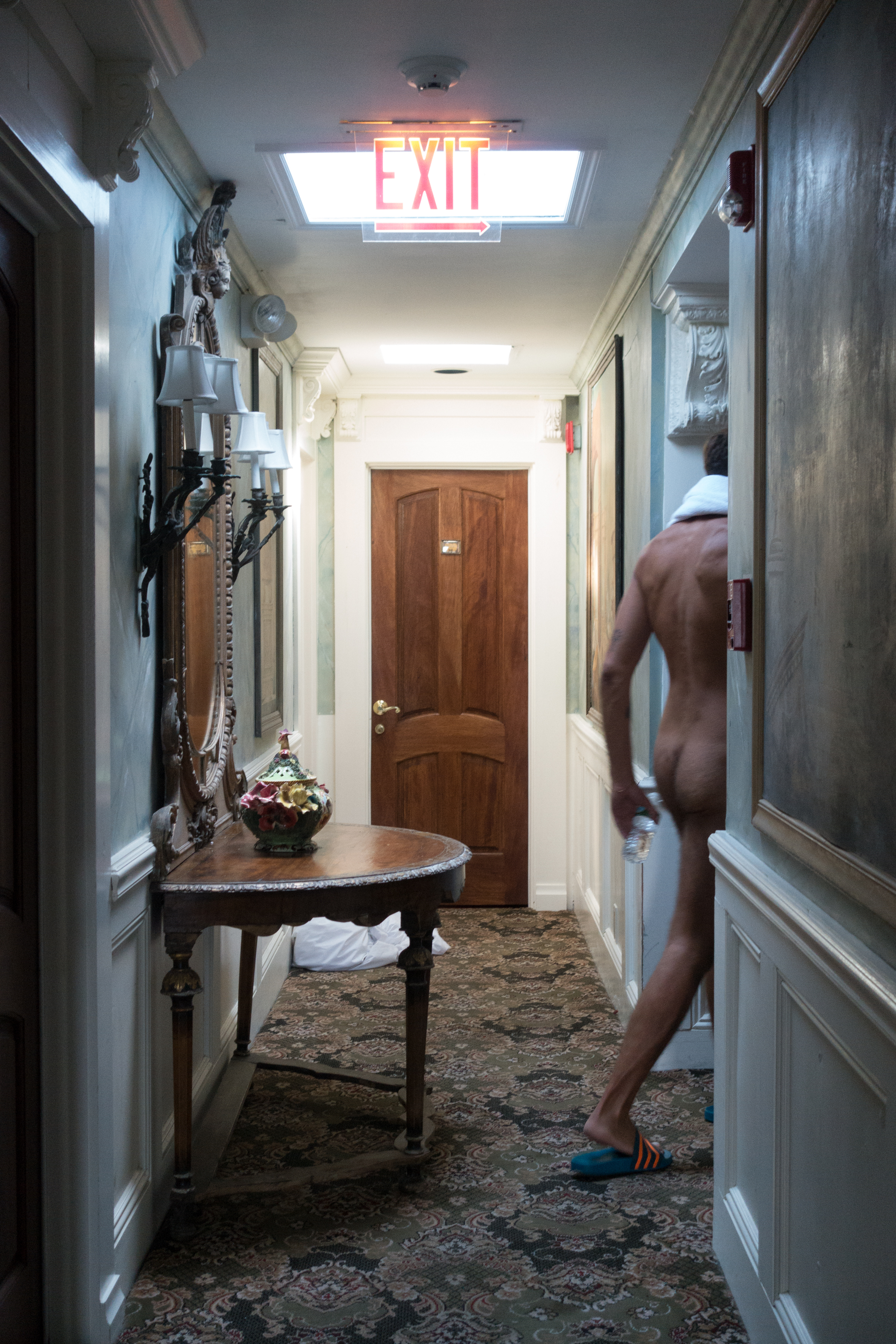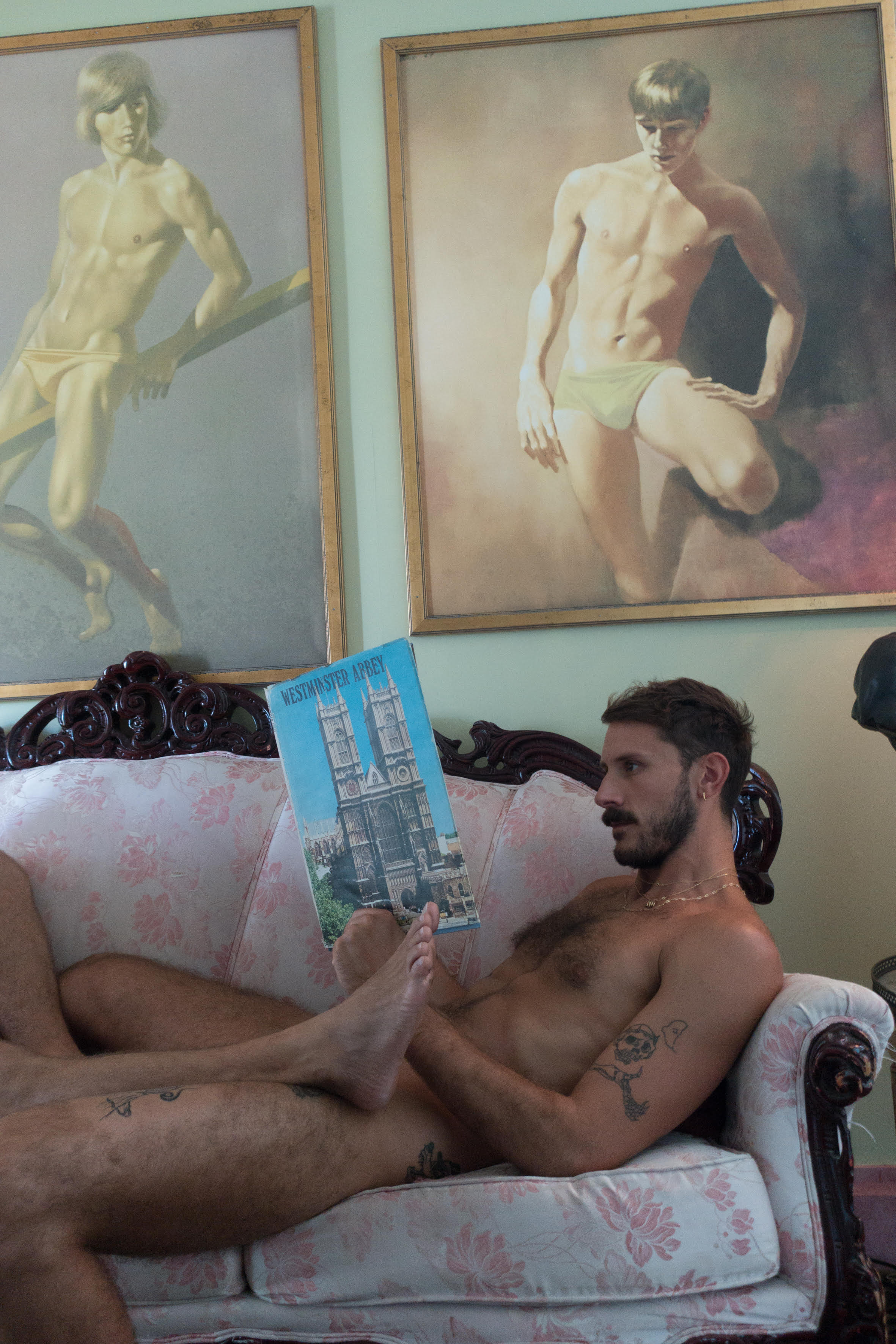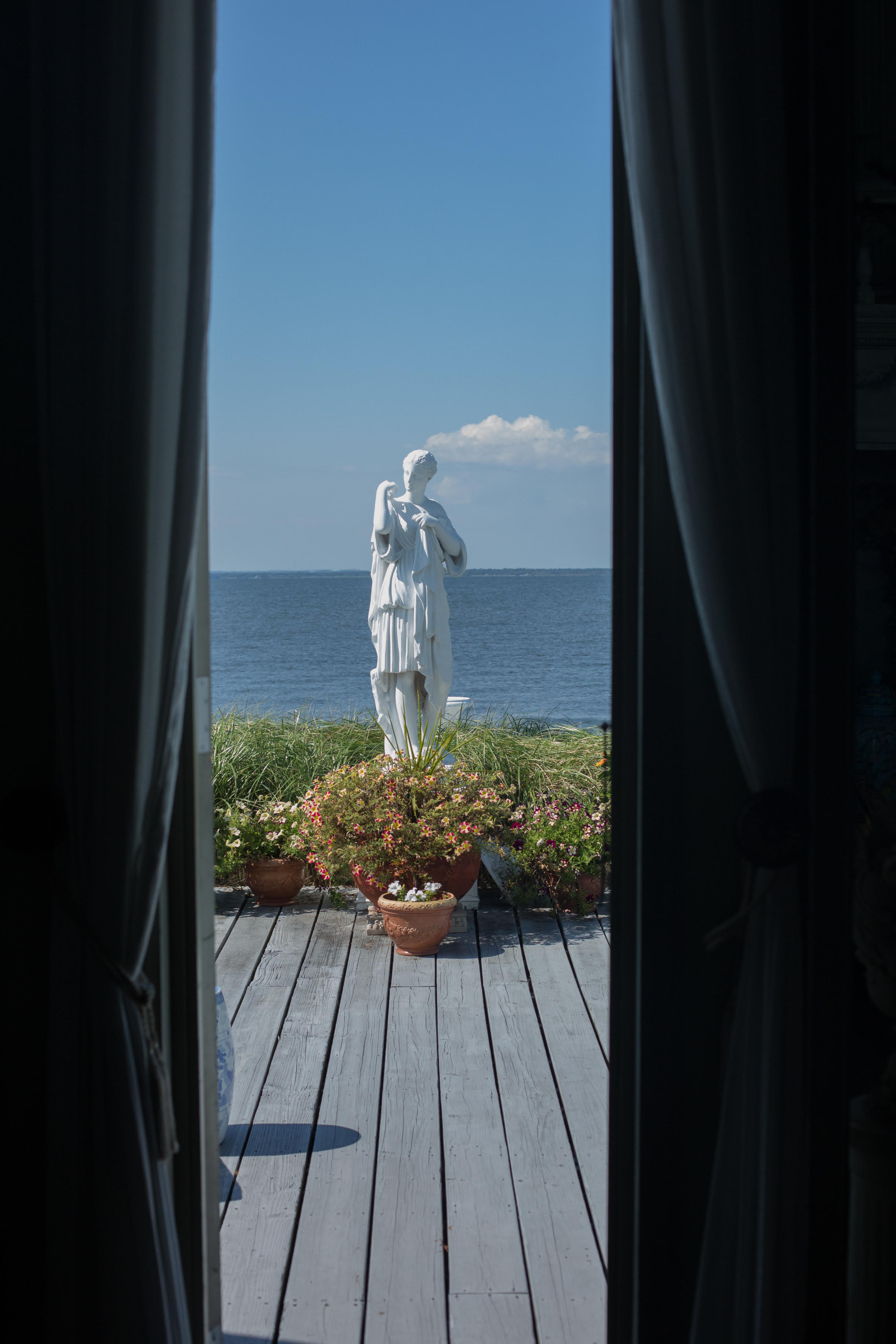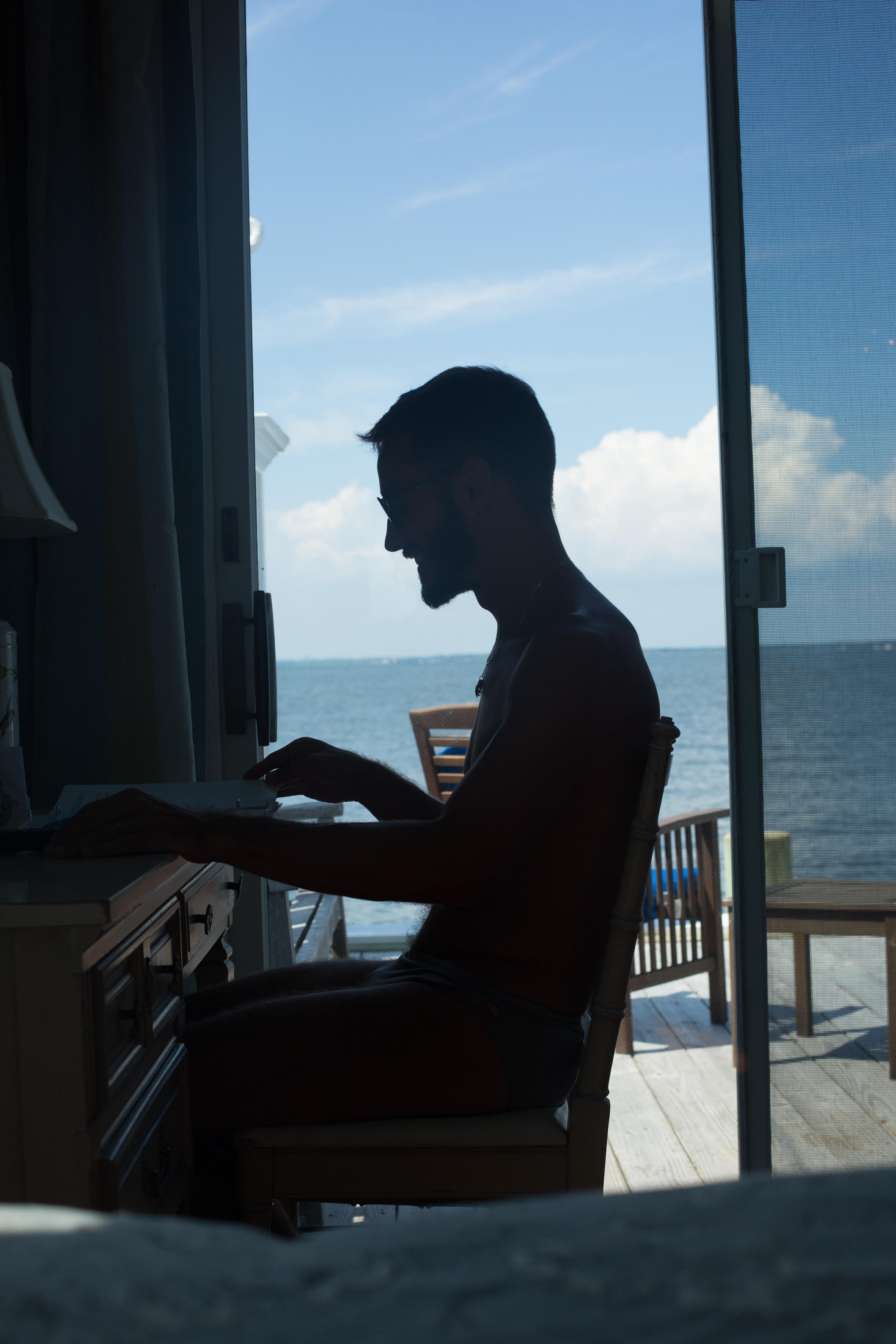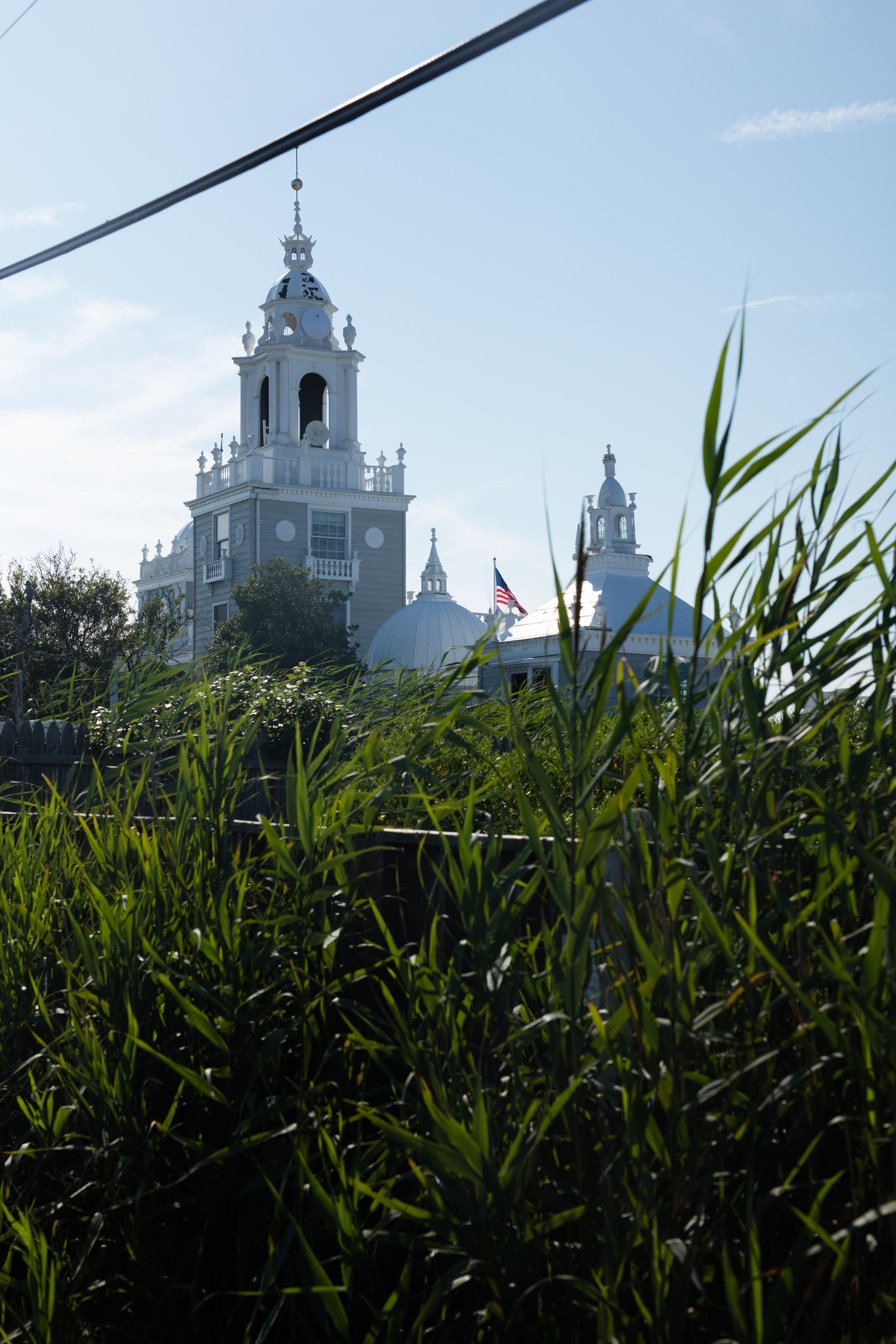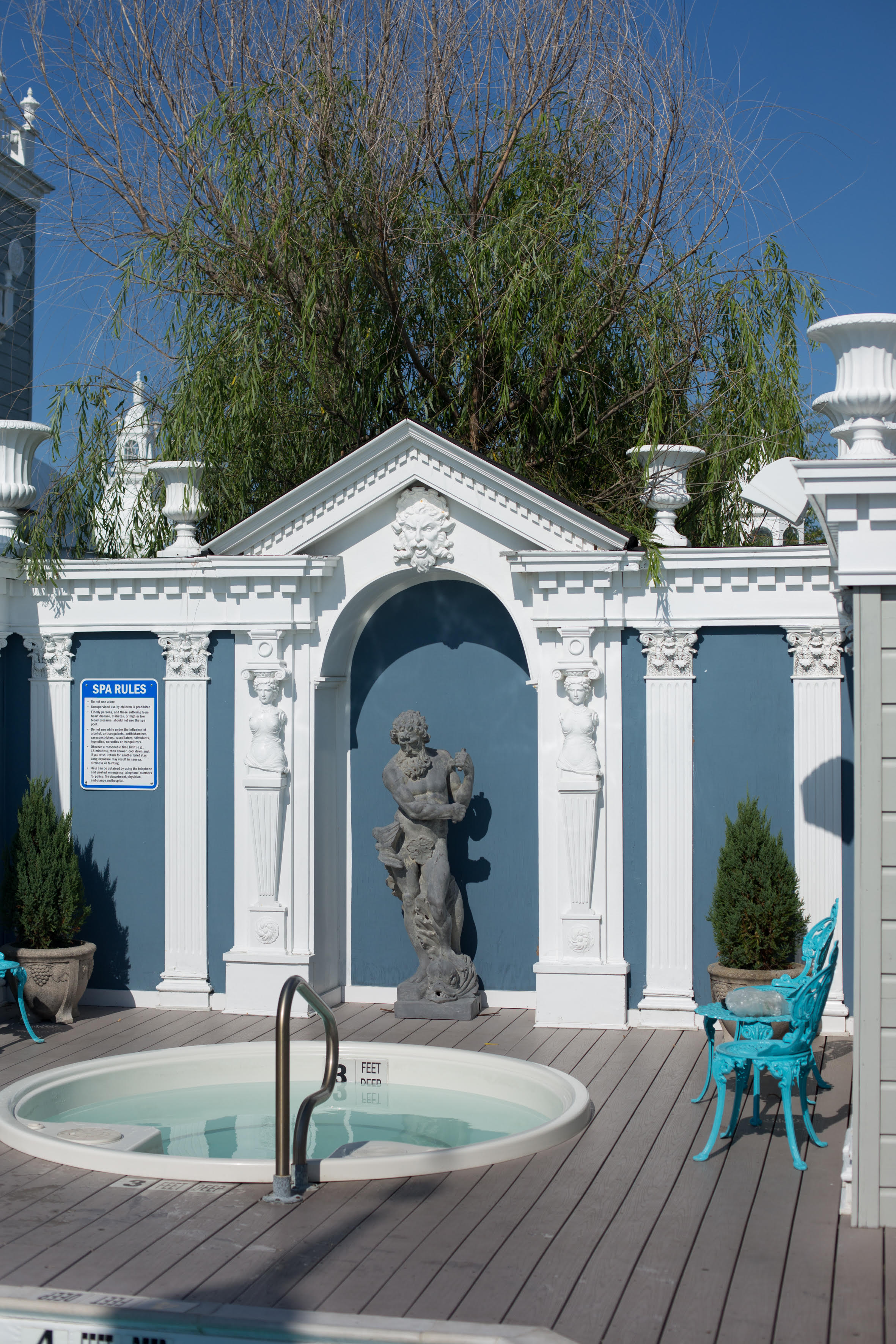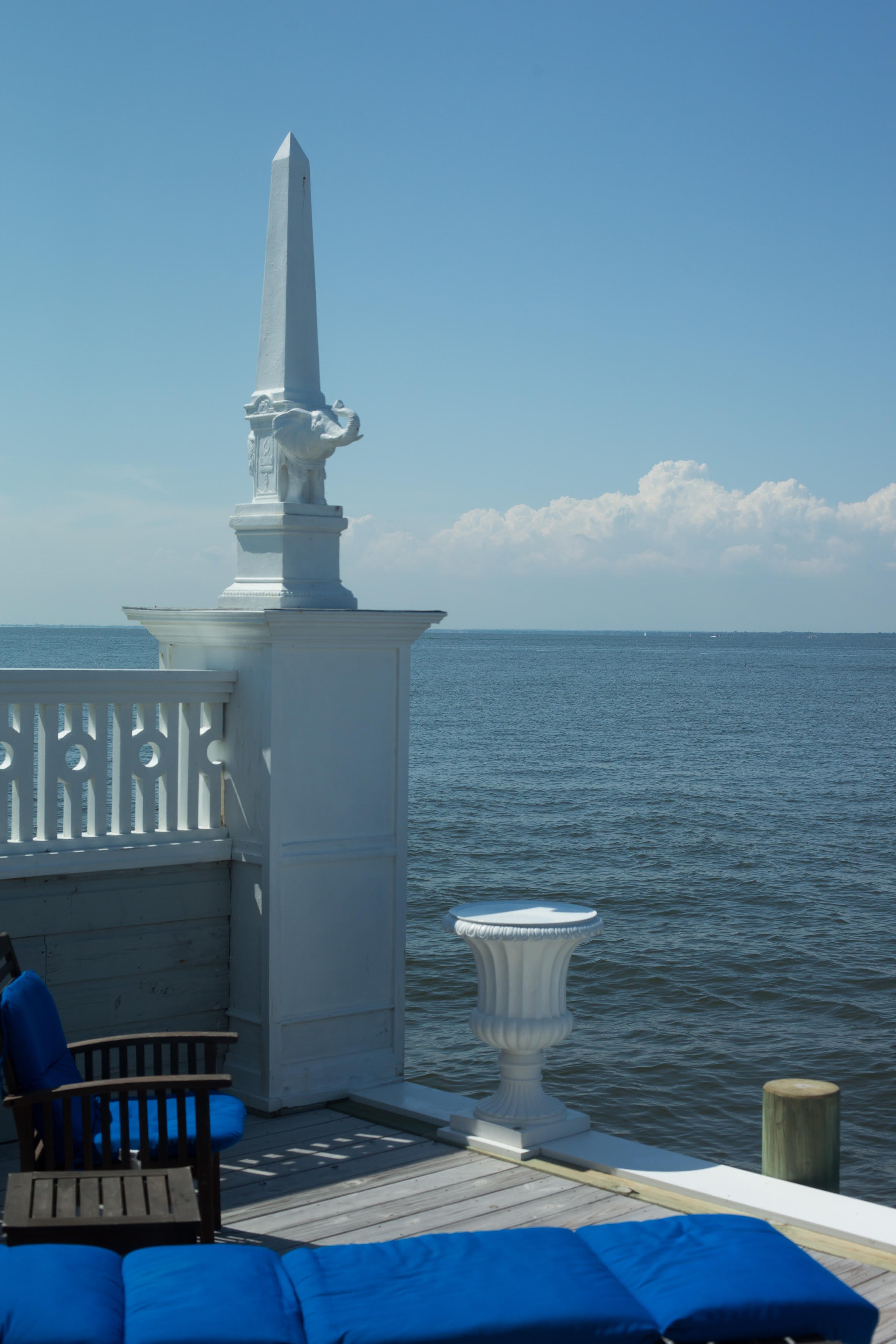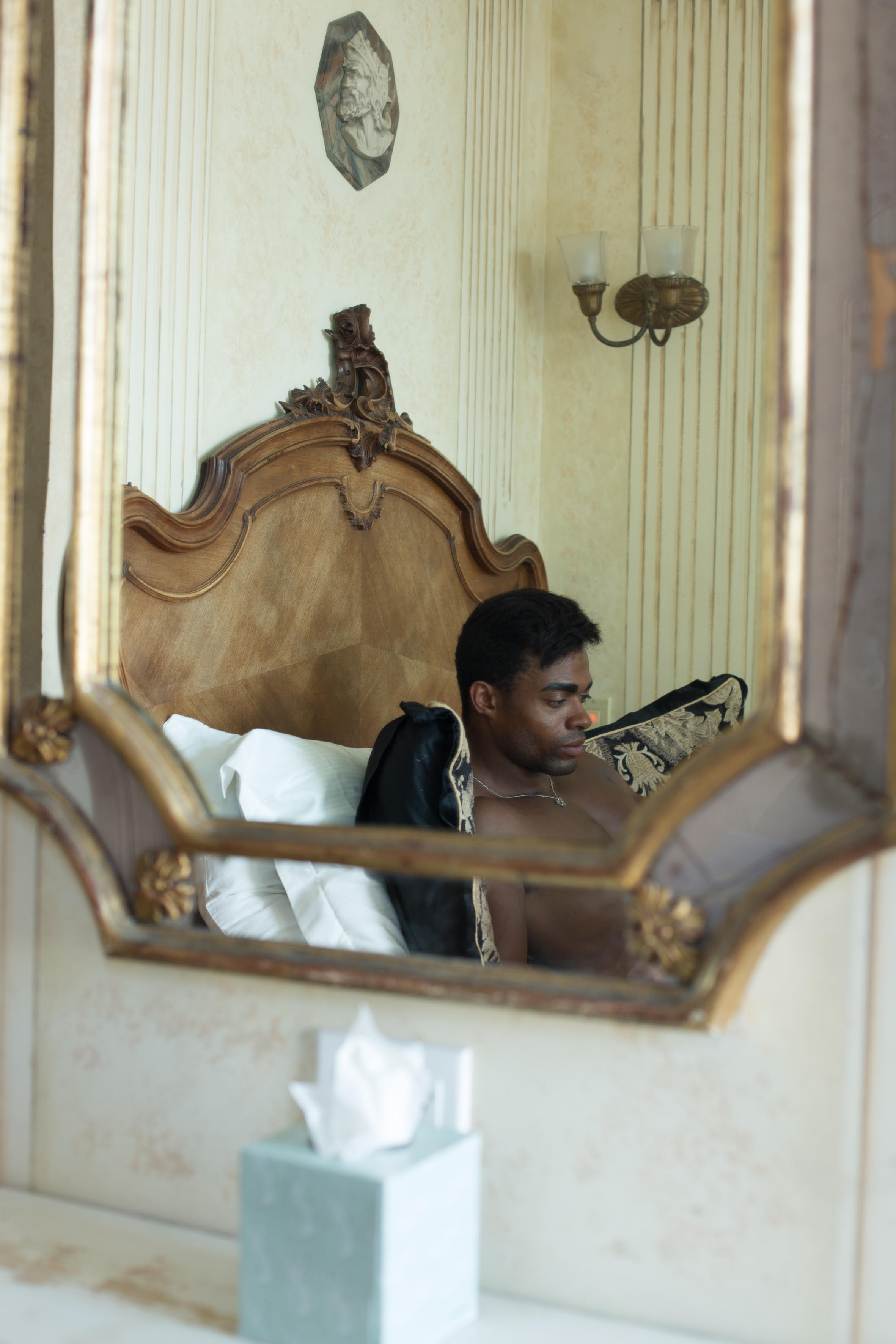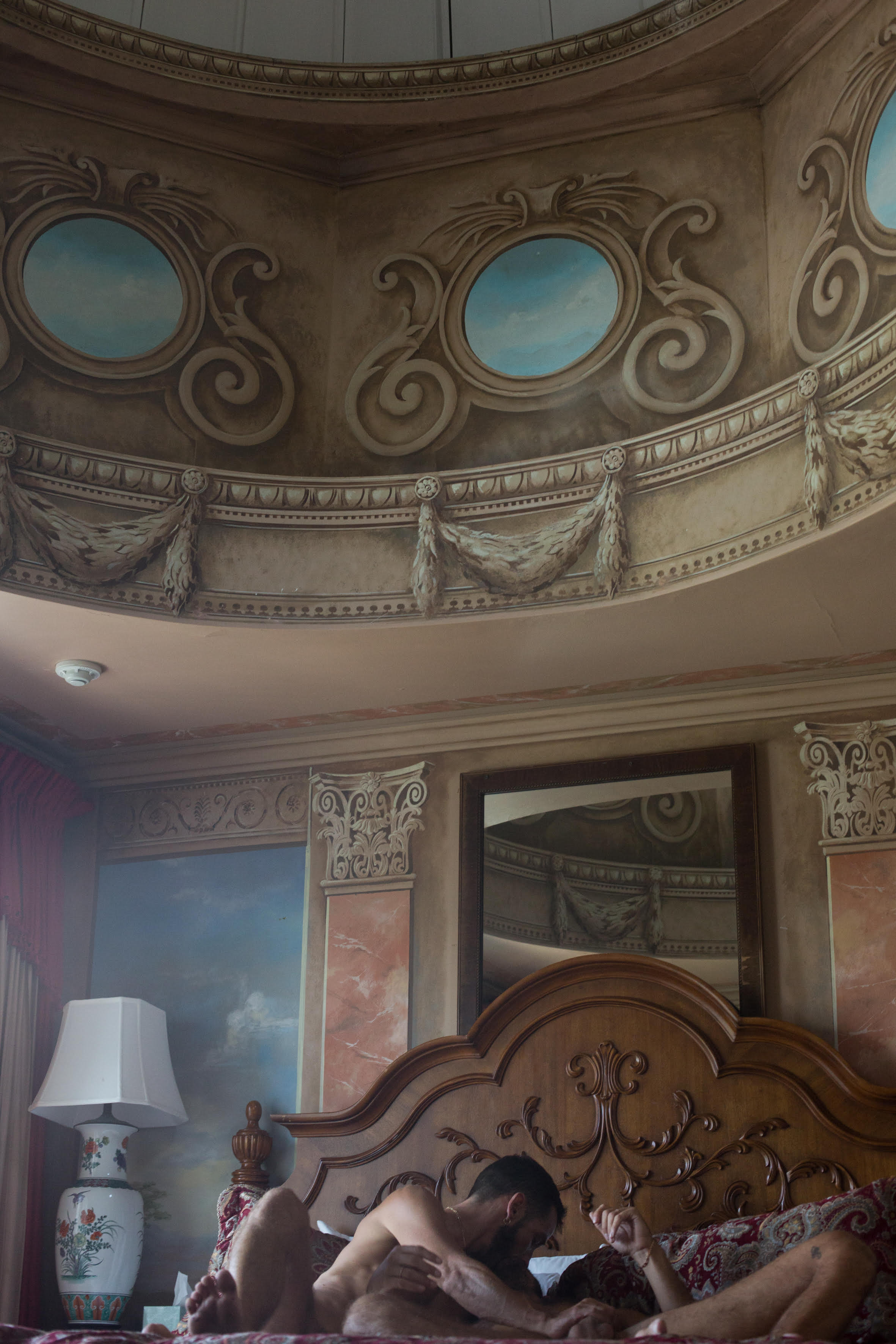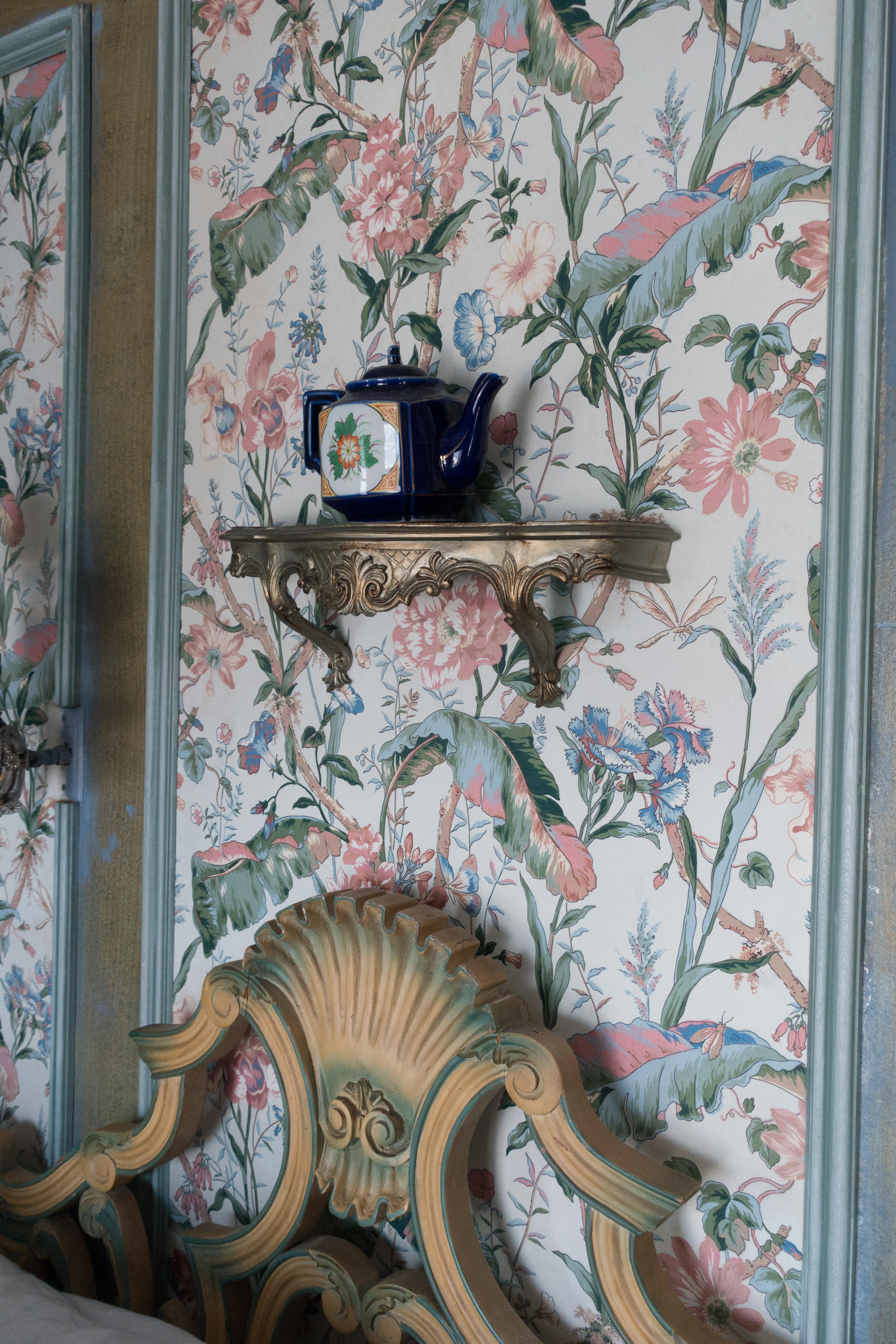THE BELVEDERE
Interview by Michael Bullock
Photography by Wolfgang Tillmans
Apartamento 20, 2017
When Fire Island virgins first take the nighttime ferry from Sayville to Cherry Grove, a unique visual sensation occurs as they approach the quaint but famous beach town. Towering above the multitude of tiny summer cottages is a baroque beacon of light, a sprawling, shimmering palace that is so wonderfully out of place that for a moment you’re certain it must be a mirage. This fantasy structure sparks immediate fascination. How did an Italian palazzo end up off the coast of Long Island? Who created such a spectacle? The front gate, (comprised of mirrored arches, a fountains and statues of lions and goddess) only offers another layer of intrigue, a sign simply states: “ Belvedere Guesthouse for Men, Fire Islands Finest.”
Established in the mid 1950’s, the Belvedere immediately became an icon of Fire Island indulgence but unless you have stayed here yourself its storied past remains a mystery. For Apartamento’s ten-year anniversary I sat down with its owner and co-creator Craig Eberhardt and his husband Julian Dorcelien to learn the secrets of their bewitching estate. What unfolds is a tale of the unlikely dream of John Eberhardt, who’s passion for fun, skill of painting, and wild vision for his own beach home made him a major force in developing the island into a gay utopia, placing him effortlessly at the core of America’s emerging gay liberation movement. The Belvedere is a story about gay pride, freedom, perseverance, dedication and decadence, and how that combination of ideals and ethics can be reflected in architecture and interior design. It’s a love story, of two couples coming together over decades to build a dreamscape to share with their community. But perhaps the most unimaginable fact about a place in which a key ingredient is hedonism, is that it’s a multi-generational family business, passed down from father to son.
Once inside the Belvedere the dramatic interiors conjure up Shakespeare’s famous quote: “All the worlds a stage and the men merely players.” On these pages artist Wolfgang Tillmans presents a portfolio that shares the voyeuristic experience that can be expected when you're a guest at Craig and Julian’s illustrious beach home.
Michael Bullock: How and when did Cherry Grove and the Pines start to evolve into a gay utopia?
Craig Eberhardt: Artist came out here going back to the 1880s but it wasn’t until after the 1938 hurricane that it started becoming predominately gay. Before then it was mostly summer house for the resident’s of Sayville but after that hurricane many of them ran out of money rebuilding so they rented them out for income and single men had disposable income. When John was 30 he came out here for the first time and instantly fell in love with Fire Island.
Was he already a successful designer?
Craig: He owned a company named On Display that created windows for department stores, designed sets for Broadway productions and createdscenic paintings for ABC and CBS. When he came to Cherry Grove he immediately started building houses. His pitch was that he could build you a house for $3800. Eventually he bought a small piece of land for himself and built the original Belvedere around the corner from here.
And as early as the late 40s John was openly gay?
Craig: He was absolutely openly gay. There were no gay bars in the city at the time so John would host enormous gay parties and charge a cover.
Did he think of himself as an activist?
Craig: More like an entrepreneur. He wanted to have fun and make money.
Wasn’t it unusual for someone to be out at that time?
Craig: Not completely, in Manhattan he had a community of openly gay men around him but what was unusual was what he did here. He built fifty-four buildings in Cherry Grove. In 1955 he sold the original Belvedere and bought this plot of land on the bay and decided to build a Venetian-style palace. It was meant to be his private house. His concept was simple; he always said, “A queen should live a palace”.
So it wasn’t originally conceived as a hotel?
Craig: No, in 1957 a fire wiped out most of the buildings and his home was one of the few that survived. There was no place for anyone to stay out here, so he rearranged the building plans and made several of the guest rooms open out on to the front porch so that he could rent them out. That fire turned the Belvedere into a guesthouse, it started with just six rooms.
It seems like a meaningful parallel that his homosexual dreamscape was born out of disasters: a hurricane and fire. The creation of the Belvedere is a vivid illustration of how the difficult circumstances pushed gay people to create their own worlds. It sounds to me like John adopted his display skills to become a builder and developer and serve the needs of his community.
Craig: He figured that renting out the rooms would let other people pay for his weekends on the island. By 1962 he was living out here full time during the summer.
His flair for the dramatic is applied to every aspect of the design here.
Craig: This whole place is a giant stage set. John had no architectural education. He was never formally trained in carpentry or construction either. His schooling was as a scenic artist. He started off as a mural painter.
He must have been at least 20 years older then you?
Craig: He was 35 years older than me. I was 21 when we met. He was fascinating to me. He had an enormous love of life and always had an optimistic attitude no matter what the circumstances. John enjoyed entertaining and I enjoyed socializing. John loved to go dancing, he loved to party, he loved to get high, all things that as a young guy in my early 20s, I loved too. I was also impressed with his enormous knowledge of architecture; at the core of our relationship was construction. I was a carpenter, so we had a great time building together. When we first met the Belvedere was only this center section and starting in 1979 we added the other three wings and expanded it from nine to thirty-six rooms.
Is it true that John adopted you?
Craig: Yes. In the late 80s we saw so many of our friends come down with AIDS. Sometimes these men had amassed fortunes and when they would get sick their family, who hadn’t talked to them in thirty years, would swoop in and kick the partner who had helped build the empire out into the street, penniless. We saw that happen over and over again. There were no legal protections for us because gay people couldn’t marry. The only option was adoption. By adopting we could become father and son which made us next of kin, then if there were decisions to be made about each other’s health or property we would be the ones to make them. So in 1980 when I was thirty he became my legal father.
That must have given you some peace of mind.
Craig: It gave me stability. It was weird because my parents were still alive so I had to ask them to sign a release that gave me up for adoption. I was very close to my father up until the day he died and I’m still very close to my mother
Did you parents have a difficult time with that?
Craig: They understood that it was the closest thing we could do to a marriage. By the time he adopted me we had already been together for about ten years. We lived in Florida in the winter and that was peculiar because on Fire Island we were a gay couple, but when we joined straight society in Palm Beach we actually did function as father and son.
Wild...and people believed that?
Craig: Absolutely. We were friendly with Tina Louise the actress who played Ginger on Gilligan's Island; she always used to chase after John and even tried to fix me up with her daughter.
That’s wild. Did it bother you to pretend?
Craig: Palm Beach is an ultra-conservative right wing town so that was the only way we could participate. I thought it was hysterical. I thought, boy…if they only knew.
And when did you two meet?
Julian Dorcelien: Craig and I had known each other for years. In 2005 he knew that I hated my job as a CNN producer so he invited me to come out for the summer to manage this place.
Craig: We started off the summer as friends and at the end of that season when we were trying to figure out where to go for the winter we realized, oh wow, were in a relationship.
Julian: So I never left. We got married for years ago.
That’s very sweet. And did you ever meet John? (I ask Julian)
Craig: Yes that first summer, we all lived here together. John and his partner Bill and Craig and me. I loved John we would always have breakfast together and he would tell me all these fantastic stories about the island.
I would love to see the rest of the place. Can you give me a tour of the property?
Craig: Sure, let’s start in the penthouse. (Julian excuses himself and Craig leads me up a spiral staircase at the top, we enter a public lounge that opens up onto a patio with a breathtaking view of the bay) Notice that table there? (He points to a circular glass coffee table that covers a hole in the floor at its base that is positioned above the same size hole in the floor bellow) We call that The Oculus and it’s designed so that when you are on the first floor, you can see through every floor all the way up here. And also so guests in the penthouse can watch new guests arriving.
Ah, clever, voyeurism by design. Did John paint all these murals?
Craig: Him and I together, he taught me to paint in this whimsical Belvedere style. The architecture here was never meant to be taken seriously. It’s deliberately designed to be high camp.
How do you define camp?
Craig: It’s an over the top fantasy. You take something past where it should go and then bringing it one step further.
Susan Sontag's famous essay "Notes on 'Camp'" defines it in harsh terms as artifice, frivolity, naïve middle-class pretentiousness, and 'shocking' excess. I prefer the simpler definition, which explains camp as: the lie that tells the truth. What do you think the value of camp in design is? What do your quest get out of it?
Craig: It’s much more fun.
It seems like it would be especially useful in a clothing optional hotel because it's a great tool to help further take your mind out of reality.
Craig: Exactly, when you walk through our gates you forget that you’re at a hotel sixty miles from Manhattan. You really have the feeling that you entered some parallel universe. Our rooms transport you all over the world. Each one is completely different. You could be in Italian cathedral, a Spanish pirate ship, a British gardenor a Burmese temple. You could be anywhere.
Is there a connection for you between camp and personal freedom?
Craig: Yes because the Belvedere totally doesn’t fit in with anything else on Fire Island or even almost anywhere else in this country for that mater. It’s completely its own thing. Since camp was John’s intention from the beginning it allowed us to design freely and flamboyantly never bound by any rules of good taste. Think of it this way, most drag queens don’t seriously try to look like a real woman. They take liberties to create a woman who is way over the top. The Belvedere is an oversized beach house in Palazzo drag. (laughs)
That perfectly sums it up.
Craig: (Craig moves the tour on to our next location the two-story living room) This is the masterpiece! We call it the Grand Salon. Were pretty sure this is the inspiration for another famous place. One of the architects for Walt Disney used to stay here in the 60’s and we think he based Disney World’s Haunted Mansion on this room. The proportions are exactly the same both are double height rooms with narrow windows and balconies with strikingly similar décor.
Brilliant. So all the visitors to Disney Land have gotten a little taste of Fire Island. What’s your favorite piece in this room?
Craig: Probably the Louis XIV parlor set over here. It’s from France, from that period. Because of the chaos after World War II John was able to get authentic museum quality antiques for relatively cheap prices. So when he first opened many of the pieces were authentic and over the years became quite valuable. We just refurnished this room with those new sofas. I had to make it a little more people friendly because we open it up for wine and cheese hour on weekend evenings.
This room sticks to the theme of an eighteenth century French palace but then there are funny things mixed in like those pretty glass palm tree…
Craig: Actually, those are on theme, there Murano glass from Venice.
Well what about that disco ball and then the leopard print pillows
Craig: Well, you have to have fun with it. The thing is that most interiors are made from elements of many periods. If people have been living in a space for 300 years there going to accumulate things. A room built in the 1700s could have furniture from the 18th, 19th, and 20th centuries.
There’s a nice balance between male and female energy with those giant sphinx statues anchoring the room.
Craig: The statues here are a constant project for us. Many of the old plaster statues that were outside turned into mud. It happens to the marble statues as well, what they call sugaring, they turn into powder from the sea salt. We send the valuable pieces to auction because it’s a crime to have them sitting out here deteriorating year after year but before there sent off we have them replicated in fiberglass so they can be here forever.
Do you feel that the copies are just as valid as the real thing?
Craig: Fakes work great in here. I’m not interested in authenticity; it’s about creating the right atmosphere.
It’s not about pedigree.
Craig: Not unless it’s homosexual pedigree. Like these giant mirrors. They came from Mae West’s townhouse in Manhattan. They had an action after she died. This Tony Duquette piece was also hers.
It makes sense that you have work by Tony Duquette’s. I see similarities between the Belvedere and his own hand built utopia: Dawnridge in Beverly Hills. Both were over the top personal visions that combed artifacts and styles from all over the world.
Craig: Duquette was brilliant. Look at this piece. Who else would combine hand-carved seagulls, twigs and seashells on a baroque mirror frame. It’s beach themed but so opulent, it looks like it was commissioned for the Belvedere.
Last time I was here didn’t you show me something from Marie Antoinette’s palace?
Craig: We used to have a bassinet from the 17th century and an appraiser told us that it may have belonged to her. It was three hundred years old and deteriorating. We thought it should go to a museum where it could be protected. So last year, I sent it off to auction.
How fitting that a palace designed for hedonism had an heirloom from the original icon of decadence. Like some subliminal reminder to your quests of what happens when you go to far. Do you do the same with paintings as with the sculpture, replace them with copies?
Craig: I have an interesting story but you need to see the newspaper clipping to believe it. (Craig takes me to look at a large reproduction of a painting of a formal portrait of John that is hung to overlooking the front courtyard pool) This was painted by Ralf Wolf Cowan the famous Palm Beach society portrait artist. He’s painted everyone every one: Princess Grace, Elvis, Michael Jackson, John Kennedy. Well Ralf presented this painting of John to us on speculation. He asked us to live with it to see if we liked it. We ended up giving it back to him but first had this photo of the painting printed on canvas. I asked him “What are you going to do with a painting of John?” He told me “Don’t worry I’ll behead him and make him into someone else”
So this painting doesn’t exist anymore?
Craig: It certainly does just not as John. Let me show, I think you will find it amusing. (Craig presents me with a clipping of a New York Times article titled A Look Inside Mar-a-Lago. The lead photo is a portrait of Donald Trump by Ralf Wolf Cowan in the same style, pose, outfit and background as the portrait of John Eberhardt’s)
Insane!
Craig: Insanely hysterical, I just blew your mind, didn’t I? This article was from last year but we learned about it a few years after we returned the painting because there was an article in the Palm Beach Post in the mid 80’s.
I hope this interview informs Mr. Trump that he’s been immortalized on a homosexual’s body. Another element that could be considered blasphemous is the tiny church you have located at the entrance to the property? Was John a religious man?
Craig: Not at all, although he was in a long-term relationship with reverend Donahue, the Archbishop of New York, but he added the chapel because all Venetian palazzos have them and he wanted to stay true to the theme.
And you actually keep ashes in there?
Craig: Yes that’s Colin and Martin. They vacationed here for years and requested in their will to spend eternity here in this chapel. Their ashes are in the box and the blue canister has some of my biological father’s ashes in it. John’s was supposed to be here as well but his last boyfriend hated Fire Island and had his remains sprinkled over Palm Beach instead.
That’s unfortunate. It would be a sin not to ask about the most memorable parties that you have thrown here?
Craig: My favorite was right after Hurricane Gloria. The bell tower had fallen down and crashed into the house and the whole quarter of the building was completely demolished. There was no electricity on the island for two weeks and the day that they allowed us to return to survey the damage was the same day as the annual end of the summer costume ball, which is a fundraiser for the Arts Project of Cherry Grove. The community house was destroyed so we decided on the spot that we would host the ball. It threw itself together in an eight-hour period. We lit the entire place by candlelight and the whole town came in period costumes from the 18th century.
Sounds perfect… That reminds me I once attended a fundraiser here and was surprised because you had a famous female singer.
Craig: Oh yes… Evelyn Champagne King performed here.
Is she the only woman that’s ever been allowed inside these walls?
Craig: No, women are welcome to attend our parties. We have female friends visit all the time. They just don’t stay as overnight guests. My mother has been here; our sisters-in-law’s have been here. This wasn’t originally built as a men-only guesthouse. It became men-only in 1984 when everybody started getting sick. They didn’t even call it AIDS, they called it GRID, Gay Related Immune Disease and nobody knew how anybody caught it. At that time there were no private bathrooms in the house and women started freaking out about having to share them with men that might be sick. We couldn’t turn our back on our community, so the solution was to make it men-only.
My female friends have felt discriminated against because they can't come inside. It will be helpful for them to understand the history.
Craig: But now after all these years of being male only and clothing optional it’s become part of our DNA. It’s a unique feature that our quests have come to expect and enjoy.
It’s an incredible accomplishment that you have been able to keep this place thriving for so many years. I respect the dedication it has taken to persist against the brutal weather and constant renovation. Because of its place in gay history and its unique architectural achievement they should declare The Belvedere a national landmark.
Craig: Whether or not it’s a national landmark it’s definitely a gay landmark. I’ve lived and worked, built and restored this place since I was a 21 year old kid. It’s a labor of love. It’s my home and my biggest pleasure is sharing it.
